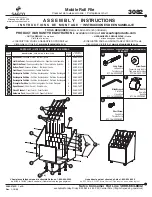
Operating the TSG-3800
Communications Settings
80
TSG-3800 User’s Guide
12778474-002-2 Revision F – March 2004
Communications Settings
TSG-3800 operation is automatic. Once you provision the operating parameters,
the unit provides outputs. If you change parameter values, or if an event such as an
input failure occurs, the changes are recorded in an event log. In addition, alarms
are provided to make the operator aware of any fault conditions.
Operating limits are preset to factory default values when shipped, but can be
changed by the operator through software control. See
Default Parameter Values
,
on page 108, for a complete listing of default values. The new settings reside in
non-volatile memory until changed again, or until you reset them to factory-default
or user-default levels.
Individual modules contain front panel indicators and monitor connectors. Refer to
the appropriate chapters in this guide for a complete description of each module.
There are two EIA-232 communication ports available: COMM A is located on the
CPU module, COMM B is located on the rear panel of the shelf. An optional
10BaseT Ethernet port is also located on the rear panel. These ports allow data
transfer between the TSG-3800 and a terminal. Each port can be configured
independently. Refer to
EIA-232 Communications
, on page 59, for details on
making connections to the ports.
The default EIA-232 communication settings are 9600 baud, no parity, 8 data bits, 1
stop bit, echo on, ASCII mode, and handshaking disabled. To change these
settings, connect a terminal device using this protocol. The ports are set to DTE,
allowing direct cables to connect to IBM compatible PCs. To change these settings,
see
Section 9.4.1, Provisioning EIA-232 Parameters, on page 298
.
Ethernet Settings
The TL1 mode allows two sessions on port 4000, Passthru mode allows one
session on port 4200, and a telnet session allows four sessions on port 23.
However, you must have an Ethernet connection and set up the Internet Protocol
settings (IP address, gateway address, and the subnet mask) through an EIA-232
port before using any of these modes. The networking parameters must be set
before network communication is possible. The IP address is the unique address for
the device. The gateway address is the default gateway address. This allows the
unit to access other networks. The subnet mask is the mask for the network class.
Note:
You can save the current configuration as user-defined
defaults. The user-defined defaults are stored in battery- backed
RAM, and are separate from the factory defaults and operating
defaults.
Artisan Technology Group - Quality Instrumentation ... Guaranteed | (888) 88-SOURCE | www.artisantg.com
















































